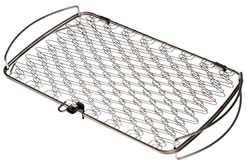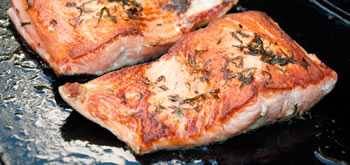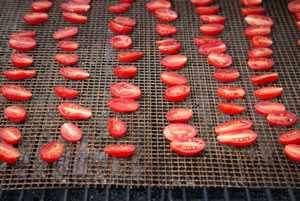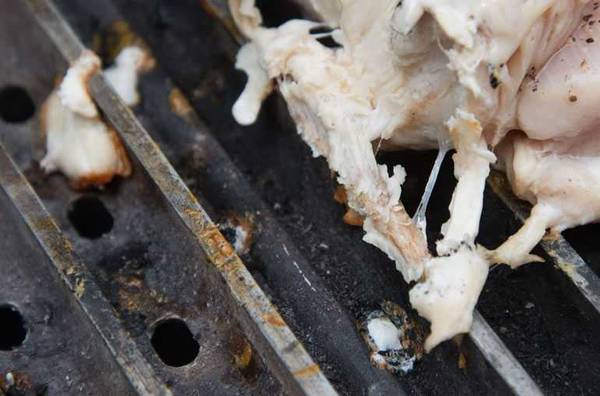Food seems to have a magnetic attraction to grill grates, and it is a shame that some of the wonderfully flavorful browned surfaces get left behind, stuck to the surface, when you go to turn it. Unfortunately, while scientists have invented many non-stick coatings, none of them can survive much above 450°F. Not much help to outdoor cooks.
The greatest barbecue and grilling author of all time is Steven Raichlen, with at least nine books and two PBS television series to his credit. He is usually right on the money, but occasionally I disagree. His famous catchphrase and signoff “Keep it hot, keep it clean, keep it lubricated” could use a re-think as we seek a way to insure no burger is left behind.
Keep it hot
Some foods clearly need to be cooked hot, but as we know, there are plenty of times when we want to cook low and slow. Especially for tough cuts of meat that will only get tougher under high heat. I discuss this in depth in my article on cooking temperatures and in my article on meat science. And as we shall see below, if you grill hot, you might even make sticking worse.
Keep it clean
This part is beyond dispute. Aged black grease on the cooking grates adds nothing positive to the flavor and food will certainly stick to the cooking surface if it has not been cleaned properly. Always pre-heat the grill before adding food, and then always clean the grates thoroughly so no grease or carbon remain.
Keep it lubricated
Some experts say you should lube the cooking grates with spray oil. This is a bad idea. The tiny droplets of aerosolized oil are highly volatile, explosive even. If they come in contact with flame, they could create a fireball and you won’t need to tweeze your eyebrows for months.
Many books say to roll up a paper towel, grab it with tongs, dunk it in vegetable oil, and swab the cooking grates. Cook’s Illustrated magazine says to repeat the process of oiling the grates 5 to 10 times. Might work, might not. It depends on the temp of the grates and what they are made from.
I asked the AmazingRibs.com science advisor Prof. Greg Blonder about the pros and cons of lubricating the grill grates: “Metal grill grates, even shiny clean ones, are not really smooth. Under a microscope there are numerous scratches, pits, valleys, and ridges. The compounds in food are much colder than the grates and when the two meet a bond forms between them. If you oil the grates, below the smoke point of the oil, let’s say 400°F, the oil actually does coat the grating and helps release protein and fat. But if you ‘keep it hot’, above the smoke point, the oil cracks, smokes, and carbonizes almost instantly. The carbon and smoke don’t taste good, and the dry uneven carbon layer simply makes sticking worse. Even at high temps if you brush on oil and then immediately add food, the oil and food cool the grate and if it cools enough, the oil may not burn off. But no way it creates a stable non-stick surface.” In some cases the oil can actually build up and make the grates more sticky!
The best way to prevent this bond is to pat your meat dry and then put some oil on the meat rather than the metal. As you lay the oiled meat down, the oil fills the microscopic nooks and crannies in both the food and the grates and makes a relatively smooth, slippery surface. The cool food lowers the temp of the grates and will keep that burnt oil residue off the food. But you want to use an oil that has a high smoke point. Most refined cooking oils will do the job. I use an inexpensive refined olive oil which has a higher smoke point (over 450°F) than extra virgin olive oil (about 375°F). Corn oil is good (about 450°F). And believe it or not, mayonnaise is very good, especially for fish. It is mostly oil with some protein and water. Remarkably, you’ll never taste it.
As the food cooks, heat causes water vapor to exit the meat where the metal is touching it because the metal transmits much more heat than the hot air around it. That’s the sizzle you hear, and it continues until the surface of the food in contact with the metal dries out a bit forming grill marks. Because oil and water don’t mix, this steam lifts the meat above the oil, and eventually the food lets go. If the food is sticking when you go to turn it, just leave it alone. Vapor from where the meat meets metal eventually steams the two apart.
Another method is to pre-cook foods. Have you noticed that the second side of the pork chop often doesn’t stick? One reason is that the top surface of the meat is going up in temp while the relatively cool underside has lowered the temp of the metal grates.
Sometimes this even works on meat with sauces. Blonder says “First, I grill one side of a chicken, then lower the heat. Then, I brush the glaze on, but only on the top surface. Close the lid and let it set-up and thicken. Then flip, and glaze the other side. This dramatically reduces sticking, because the glaze molecules have pretty much bonded to themselves, and have little interest in bonding to the cooler grate. I use a similar trick on chicken burgers or crab cakes, both very sticky patties. I place a layer of foil or a flat metal plate on the grill and oil it well. Temperature around 400°F. Then I lightly cook both sides, creating a much less sticky surface. When I transfer them to a hot grill for searing, adhesion is greatly reduced.”
Also, keep in mind, cast iron is very bumpy and that makes it sticky. It can be made slick like a cast iron frying pan, but the non-stick surface usually doesn’t last on the frill. It is your worst choice.
The fish problem
Fish is notoriously sticky, and sometimes no amount of oil will prevent it from sticking. I have several strategies for fish.
Warm it. If you are using a 2-zone setup, and you should, put the fish in the indirect cool zone for a few minutes. This warms the proteins on the surface and they don’t stick as much.
Dial back the temp. If the fish is really thick, lowering the temperature sometimes helps.


Fish basket. One method is a fish basket. Most look like two skinny tennis rackets hinged at the top. You oil the fish, lock it in between the two sides and put the meat on the grill. When it’s time to flip, it’s easy to turn. The problem is that the handles of the rackets are too long and they keep you from closing the lid of the grill. But count on Weber to come to the rescue. The Large Weber Steel Fish Basket has no handles. Yes, sometimes the fish sticks to the basket, but usually, if you oil it well, it releases before you remove it.

Griddle. Lightly coated with oil, I put the fish flesh side down on a screaming hot cast iron or stainless steel griddle. It browns rapidly and lets go within minutes. Then I flip. Skin on or skin off, the surfaces brown nicely and the interior roasts beautifully. I throw dried herbs onto the fire to create a lot of smoke in a short amount of time because fish cooks quickly. The Lodge griddle is designed without a groove around the perimeter so the oil stays on the flat surface. I also use a large double Lamson fish tongs for flipping. They’re great at lifting the whole thing without breaking it. If the fish is really thick, you might need to dial the temp back. Here’s a recipe for salmon done that way, and more about the technique.
GrillGrates. Another strategy is to use GrillGrates (TM) described above. They come with a special spatula with fingers that go into the valleys between the rails and get under the fish and lift it evenly and gently. They also sell hybrid tongs and spatulas like LamsonSharp but with the fingers matching the groves in the grates.

Grill Toppers. The best strategy is Frogmats. These are sheets of non-stick mesh that allow an all over sear and prevent sticking. The non-stick material can’t be heated above 400°F, but you don’t have to cook fish that hot anyway. Click the link to read more about Frogmats.
No matter what you do, sometimes the food just wants to stick. Blonder says “Learn how to slide a thin spatula at an angle to the grates to shear off stuck food, retaining most of the browned surface. This is a skill worth mastering.” I have a spatula that I have taken down to the grinder in my basement workshop and ground the front edge to a nice taper just for this purpose.



High quality websites are expensive to run. If you help us, we’ll pay you back bigtime with an ad-free experience and a lot of freebies!
Millions come to AmazingRibs.com every month for high quality tested recipes, tips on technique, science, mythbusting, product reviews, and inspiration. But it is expensive to run a website with more than 2,000 pages and we don’t have a big corporate partner to subsidize us.
Our most important source of sustenance is people who join our Pitmaster Club. But please don’t think of it as a donation. Members get MANY great benefits. We block all third-party ads, we give members free ebooks, magazines, interviews, webinars, more recipes, a monthly sweepstakes with prizes worth up to $2,000, discounts on products, and best of all a community of like-minded cooks free of flame wars. Click below to see all the benefits, take a free 30 day trial, and help keep this site alive.
Post comments and questions below
1) Please try the search box at the top of every page before you ask for help.
2) Try to post your question to the appropriate page.
3) Tell us everything we need to know to help such as the type of cooker and thermometer. Dial thermometers are often off by as much as 50°F so if you are not using a good digital thermometer we probably can’t help you with time and temp questions. Please read this article about thermometers.
4) If you are a member of the Pitmaster Club, your comments login is probably different.
5) Posts with links in them may not appear immediately.
Moderators